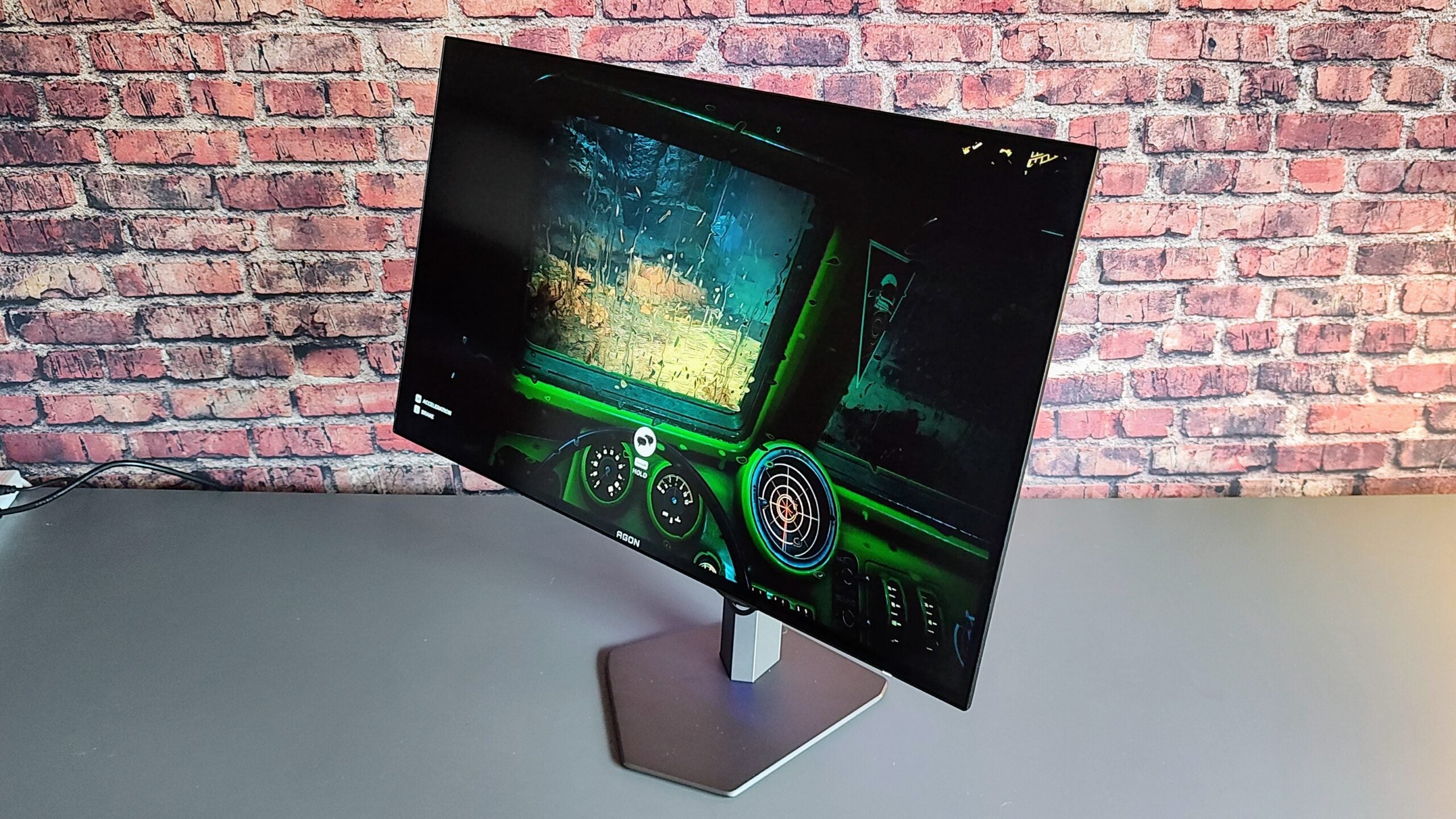Verdict
Stylish and affordable, the AOC Agon Pro AG276QZD is the best-value 27-inch OLED gaming monitor on the market.
Pros
- Stunning OLED display
- Excellent motion fidelity
- Compact stand
- Good value
Cons
- Speakers distort at maximum volume
- HDMI ports are v2.0 not 2.1
-
OLED display27-inch 2,650 x 1,440 240Hz OLED display for gaming and watching video.
-
Loud speaker systemThe 2 x 5W sound system inside. -
Compact stand and asymmetric designThe stand has a very small footprint and features an interesting and stylish design.
Introduction
The AOC Agon Pro AG276QZD OLED gaming monitor was supposed to be launched in the UK and Western Europe last autumn, but the release was delayed, as far as we can gather, due to a rather lukewarm reception in the US market, where it was released in the late summer of 2023.
Now the Agon Pro AG276QZD has finally rocked up in Blighty, sporting brand new firmware that apparently fixes the pesky brightness issues that some American journalists noted and a rather aggressive price tag – at the time of writing, Amazon is selling it for £849, but last week it was down to £810.
The Agon Pro AG276QZD also boasts the same LG-made 27-inch 1440p 240Hz OLED panel as the likes of the LG UltraGear 27GR95QE and Asus ROG’s Swift PG27AQDM which means that somewhat counter-intuitively, the quality of the panel isn’t going to be what makes or breaks the AOC Agon Pro AG276QZD.
Design
- Interesting asymmetric design
- Four video inputs
- Lightweight for a 27-inch monitor
In a world of highly rectangular monitors, the Agon Pro AG276QZD is unusually asymmetrical. It may look conventional from the front, but look at the rear, and you will see that the cabinet is an angular off-centre affair when looked at directly and from the top. Even the polygonal LED light array on the rear and the OSD toggle are asymmetrical.
The asymmetric vibe continues with the stand, which is an impressively compact affair that sticks out further to one side than the other. It occupies much less space as a design than the competition from LG and Asus ROG monitors, but it is no less stable. That asymmetric stand does make placing it squarely something of a challenge until you learn to use the back rather than the front edge of the plinth as a guide.
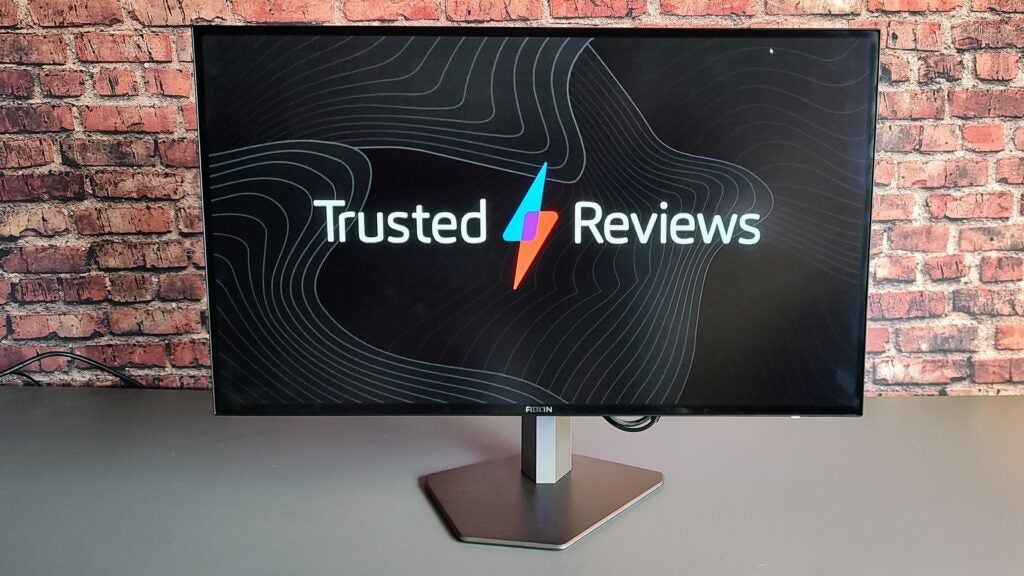
The rather unorthodox design of the Agon Pro AG276QZD’s stand hasn’t had an impact on functionality: There’s plenty of adjustment available with a 90° pivot to both left and right, 30° swivel, 130mm of height adjustment and tilt between -4 and 21.5°. The stand and the cabinet mate with a bespoke quick-release mechanism, but AOC bundles the necessary hardware to attach it to a 100mm x 100mm VESA bracket.
The selection of ports is a strong point thanks to two HDMI 2.0 ports and two DisplayPort 1.4 video ports compared to the alternatives from LG and Asus ROG, which only have three video inputs; 2 x HDMI and 1 x DisplayPort. Alongside the video inputs, you’ll find a 3.5mm audio jack, the input for the external power supply and three USB ports.
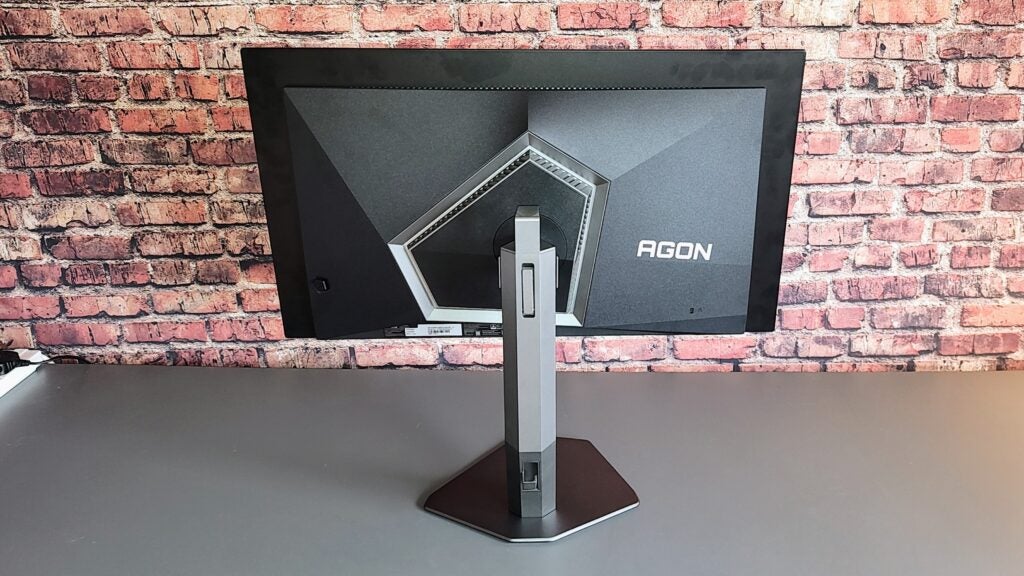

The placing of the ports doesn’t lend itself towards easy access, but the fact that the Agon is rather light for a 27-inch monitor at just 6.4kg, including the stand, does make it easy to tilt over for improved access.
The two DisplayPort 1.4 inputs can handle the monitor’s 1440p resolution at its maximum refresh rate of 240Hz, but the HDMI 2.0 ports are limited to 144Hz. If you want HDMI 2.1 ports that support Variable Refresh Rate (VRR) on the latest gaming consoles, you’ll need to opt for the UltraGear 27GR95QE.
The USB hub is a basic affair consisting of two 5Gpbs USB-A downstream and one USB-B upstream connector. That’s good enough to connect your mouse and keyboard to the monitor, but in the absence of a Type-C video input, there is no KVM functionality.
Image Quality
- Impressive brightness levels in SDR and HDR mode
- Wide colour gamut coverage
- Excellent motion fidelity
Early versions of the AG276QZD were criticised for lacklustre brightness levels, but my review unit hit 380nits in SDR mode and over 810nits from a small screen area (<10%) in HDR mode, which is perfectly acceptable and a match for the best of the OLED competition.
Colour gamut coverage is good, with 99.2% sRGB, 88.8% DCI-P3 and 88.2% Adobe RGB. There are two industry-standard colour profiles you can lock to, sRGB, against which we recorded a Delta E variance of 1.1 and DCI-P3, against which the Delta E came out at 1.6. Those are both very solid results for a gaming monitor.
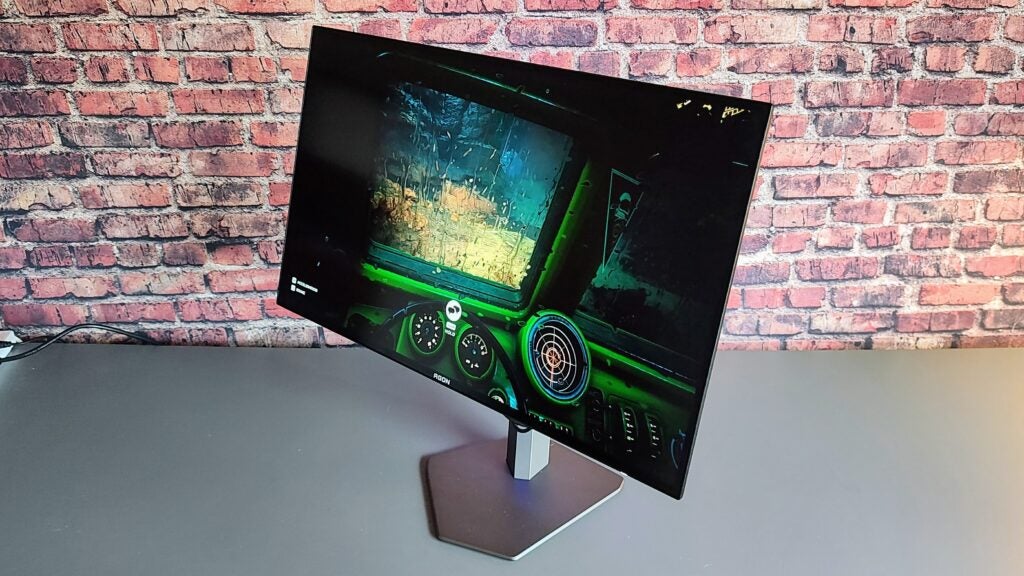

There’s nothing in the way of a VESA TrueBlack HDR certificate, something also true of LG UltraGear 27GR95QE so you need to make do with basic HDR10, but HDR content still looks mighty impressive with superb OLED-infinite contrast and colours that pop out of the screen.
Like the LG UltraGear 27GR95QE, the new Agon Pro has a slightly matte anti-glare finish to the screen. Matte finishes do a better job of keeping reflections at bay, but full-gloss finishes look just that little sharper and more immersive, at least in my book. Which is best depends on how much you need to keep reflections at bay.
Motion handling is just about perfect. I’d expect little else from an OLED screen with a 0.03ms GtG response time and a 240Hz refresh rate. Ghosting, smearing and blurring are noticeable only in their absence. Thanks to official support for Nvidia’s G-Sync adaptive sync screen tearing is not something you need worry about.
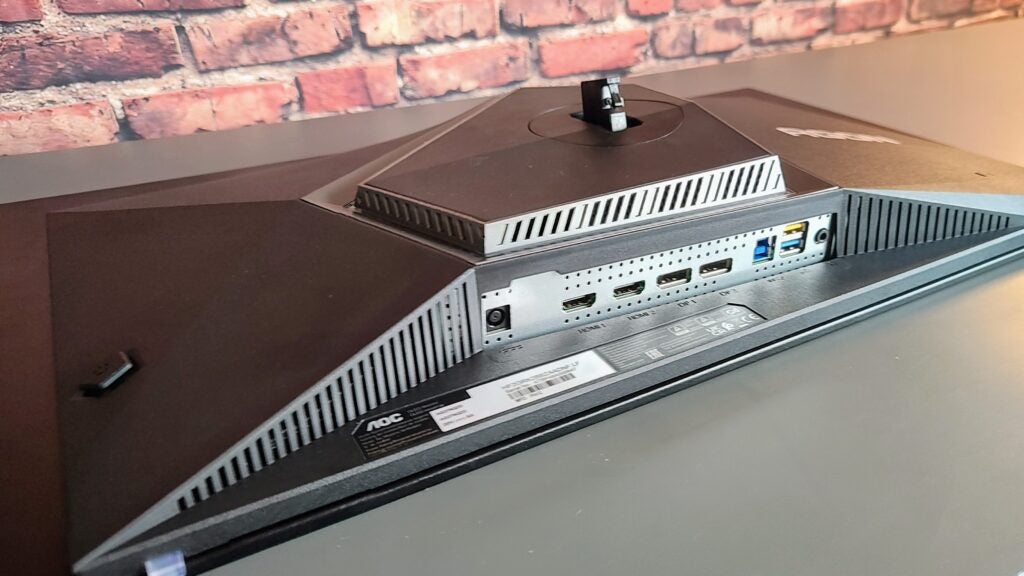

The Agon Pro AG276QZD displayed impressive uniformity of brightness with minimal variance across the panel, while the default gamma was bang on at 2.21. The visual colour temperature was equally on the ball with a reading of 6542K, which was almost bang on the ideal 6500K.
I don’t personally regard OLED burn-in as something to worry about, at least not when it comes to gaming monitors, which tend not to have static graphics showing for long periods as they can do on OLED TVs. Some people see it as an issue, so Agon has installed several acronym-heavy systems designed to prevent burn-in, which can all be accessed from a dedicated menu. These include LEA (Logo Extraction Algorithm) and TPC (Temporal Peak Luminance Control), which reduce the brightness of stationary images; ORF (Off Real Slow), which is a 10-minute pixel wash; and Orbiting, a four-level pixel shift function.
Software and Features
- Funky rear LED light array
- Loud stereo speakers
- OSD menu is easy to navigate
If you like a little ambient light with your gaming, then Agon as you converged with the 5-sided LED lighting system on the back of the cabinet called LightFX. This has a wide range of effects and colour options, some of which can be set to match the monitor’s audio output but not the video display and is pretty impressive in a dark or near-dark room, though it lacks the brightness and display-matching capabilities of the Philips Ambiglow system fitted to its Evnia monitors like the 42-inch 42M2N8900.
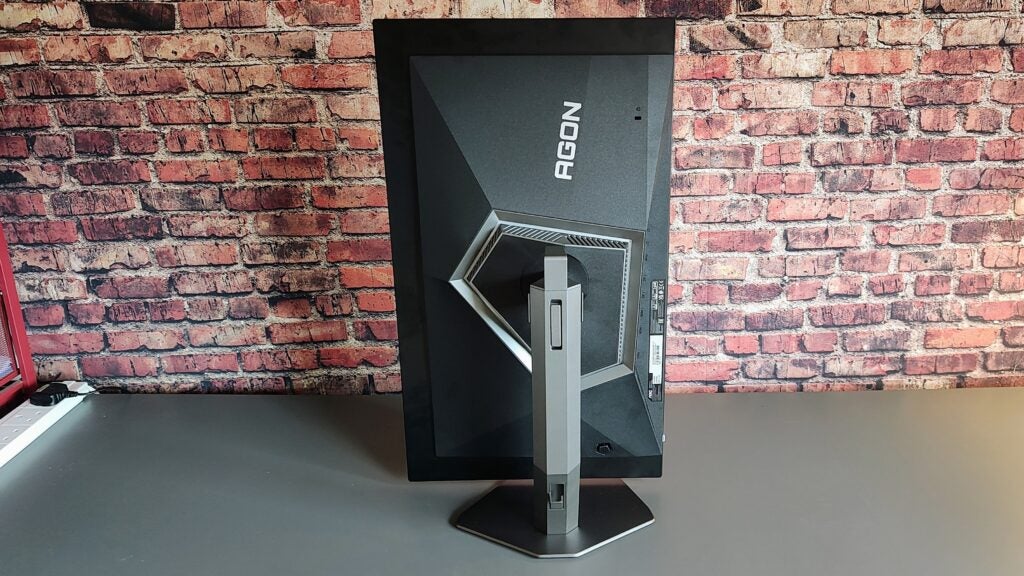

The 5W speakers buried inside the cabinet develop an impressive amount of volume – over 81dBA – but they do get rather raucous when pushed to the limit. There’s not much in the way of bass, either. Of course, the LG and Asus ROG competitors don’t have speakers at all, so it’s unfair to beat the new AG276QZD too hard on this account.
Agon’s OSD menu may not be the easiest on the eye – the red and black colour scheme makes it look rather cheap –but it’s very easy to navigate and is home to all the gaming refinements you would expect, like a shadow boost, frame rate counter and sniper mode. I was particularly taken with the 20-level Game Color (sic) setting that lets you adjust the colour saturation, which is handy if, like me, you like a rather excessive amount of colour in your games.
Latest deals
Should you buy it?
Compact and affordable OLED gaming
Compared to its direct competition, Agon Pro AG276QZD is lighter, more stylish, has built-in speakers and is either as cheap or cheaper depending on where and when you look.
If you want a monitor just for console gaming
The Agon Pro AG276QZD uses HDMI 2.0 rather than 2.1 ports. The LG UltraGear 27GR95QE uses v.2 1 ports that offer VRR support. That makes the LG a better bet for gamers with the latest console hardware.
Final Thoughts
The question is whether you should buy the new AOC Agon Pro AG276QZD in preference to the Asus ROG Swift PG27AQDM or the LG UltraGear 27GR95QE, both of which use the same LG-made panel. Ultimately, it may come down to price.
The manufacturer’s RRP of the new Agon Pro AG276QZD is £849, but as I noted at the start, I’ve seen it on Amazon for £810. Asus is now selling the PG27AQDM for £899, and LG has dropped the price of the UltraGear 27GR95QE to £849. These prices make it a tight contest between some of the best monitors around sporting the same panel.
In terms of performance, there is very little to distinguish between the three: All have the same LG-made OLED panel, and all offer a top-notch visual gaming experience. The new Agon has a more interesting design, its stand has by far the smallest footprint, and it’s the only one of the three to have built-in speakers, which makes it the more complete package and, for that reason, I’d give it the nod over the competition.
How we test
We use every monitor we test for at least a week. During that time, we’ll check it for ease of use and put it through its paces by using it for both everyday tasks and more specialist, colour-sensitive work.
We also check its colours and image quality with a colorimeter to test its coverage and the display’s quality.
We used it as our main monitor for at least a week.
We used a colorimeter to get benchmark results.
We used our own expert judgement for image quality.
FAQs
Those are the three levels of AOC’s gaming monitor range, with AOC Gaming being the budget offering, Agon the core gaming line-up and Agon Pro catering to the high-spec gaming fraternity.
All AOC monitors come with a 3-Year Warranty which includes coverage for OLED burn-in.
Trusted Reviews test data
Brightness (SDR)
Brightness (HDR)
Black level
Contrast ratio
White Visual Colour Temperature
sRGB
Adobe RGB
DCI-P3
Delta Colour accuracy (Delta E)
›
UK RRP
Manufacturer
Screen Size
Size (Dimensions)
Weight
ASIN
Release Date
First Reviewed Date
Model Number
Resolution
HDR
Types of HDR
Refresh Rate
Ports
Display Technology
Syncing Technology
›
